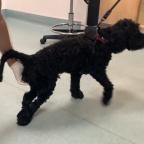
8 Most Common Skin Problems in Dogs and How to Treat Them
From redness to hair loss, here's how to recognise the signs of common issues like ringworm, parasitic infection and allergies so you can treat the issue quickly.
There are multiple skin problems that your pup is likely to encounter in its lifetime. When left untreated they can decrease their quality of life - so it's important to recognise what they are, how to spot them and how to deal with them effectively.
The team at tails.com wants pet owners to understand some of the most common skin conditions that their dogs may face as well as how to recognise the common symptoms.
Please find the comments from tails.com attached below. If the content is used a link must be provided to https://tails.com/gb/diet/hypoallergenic-dog-food/
Eight most common types of skin conditions in dogs
Skin problems are extremely common in dogs. Possible causes can range from parasites and allergies to injuries and what might start as a scratch can turn into excessive licking, chewing and scratching. Here are the most common symptoms to watch out for;
- Itching and scratching
- Redness
- Irritation and discomfort
- Scabbed, scaly or flaking skin
- Dry skin
- Excessive licking or chewing
- Red, watery eyes
- Sneezing
- Hair loss, bald patches
- Greasy coat
- Hot spots
- Lumps and swelling
- Lesions and scabs
Our four-legged friends can develop skin conditions in the same way that we can. Unfortunately, they can't tell us what the issue is so sometimes it is hard for pet parents to recognise the symptoms straight away. While the visual cues are more noticeable, understanding the cause of your pup's skin condition can be challenging.
Here is a guide to some of the most common skin conditions and how to treat them.
-
Ringworm
Ringworm is not a life-threatening condition, but if left untreated it can cause discomfort to dogs. The disease requires a visit to the vets as it is extremely contagious and can be passed to humans or other pets. In both humans and dogs, the fungal infection usually presents itself in circular areas of hair loss across the body. Young, elderly and long-haired dogs are the most commonly affected. Crusted ringworm lesions appear on paws, legs, head and ears, but they can appear on any part of the dog's body.
Redness and inflammation may appear on your dog skin from where they have irritated the area by scratching and licking. It's crucial to contact your vet immediately if you spot the signs of ringworm - as they can prescribe you treatment to prevent the infection from spreading.
-
Food allergies
Skin conditions caused by food reactions occur following ingestion of one of more allergy-causing substances in your dog's food. A hypoallergenic diet will eliminate the problem ingredients that can cause a reaction for dogs, these include beef, dairy, soya and wheat. Tails.com have a hypoallergenic dog food formulated specifically for dogs who suffer from food-based allergies.
The physical reaction is excessive non-seasonal itching, often the face, feet, ears and anus and vomiting, diarrhoea, frequent bowel movements, sores and baldness due to scratching. Similar to humans who experience food allergies, dogs must have an elimination diet to rule out the potential causes of the allergic reaction. Pet parents must avoid feeding their pups any food substances that cause the symptoms to return.
Medication will be supplied by your vet and they will prescribe a treatment process.
-
Parasites
Parasites in dogs can cause anything from mild irritation to serious illness and can impact your pet's health and comfort. The most common parasites to infect your dog is fleas and ticks.
There are many products on the market for treating fleas, some more effective than others. Some products only kill or repel fully-grown adult fleas, whereas others are also effective against flea eggs too. The best advice is to speak to your vet who will be able to suggest a product suited to your dog's needs.
While common skin conditions such as fleas and ticks are easily recognisable for dog owners to spot and identify, intestinal parasites can be present inside your dog without your realizing it. Internal parasites like roundworms, hookworms, whipworms, tapeworms can cause dull skin and coat.
-
Yeast infection
Constant itching and irritated skin with a distinct odour can be an indication of a yeast infection, a common skin condition for dogs. A yeast infection is typically found on the skin or in the ears. This form of infection can cause extreme discomfort as it is an overabundance of yeast on the body of the dog. Yeasts are forms of fungi that live in your dog's gut without causing illness, when they grow your dog will start to suffer from a fungal infection.
Common signs of a yeast infection include; excessive chewing or licking feet, dark red hair between the toes, black skin, hair loss, odour from the skin, greasy hair, ear infection, repetitive head shaking, speckles under the belly and diarrhoea.
Dog's can develop a yeast infection in their ears or on their skin if they have food allergies or environmental allergies. Hot weather, skin irritation and pre-existing skin conditions are all factors that can increase the likelihood of a yeast infection.
Despite the common myth, yeast extracts in certain dog foods are there to provide amino acids and B-vitamins in particular and are not the same yeasts that cause a skin infection.
-
Dandruff
Just like humans, dogs can suffer from dandruff or scurf as it's more commonly known. While in humans dandruff affects the scalp area, in dogs it's most common in the back and towards the tail. If your dog is suffering from dandruff you will see white flakes on their coat, or in places where they like to relax. You may also find flakes when you are stroking or scratching their coat.
There are a variety of things that can cause dandruff in dogs and any breed can be affected. One of the most common causes is the imbalance of oil produced by the sebaceous glands that keep the skin moist. When too much is produced it causes seborrheic dermatitis.
But more often it's either caused by an underlying health condition or something within the environment. Dandruff can be treated with specialised shampoos but it's important to visit the vet as they will check for any underlying conditions. A diet tailored to dry skin or coat will benefit levels of essential fatty acids such as Omega 3 which will help boost skin health and tackle a dandruff break out.
-
Bacterial infection
Dogs are vulnerable to a range of bacterial infections that can affect the respiratory system (organs and other parts of the body involved in breathing), skin, ears, urinary tract and kidneys. Affected dogs will experience itchy skin, which can become red and have rashes, crusts and small pus-filled spots.
Most bacterial infections caught by dogs can be cleared up with antibiotics and anti-inflammatory medication. But if left untreated they can lead to severe health issues.
When a dog's immune system is weakened, it is easier for them to get a bacterial infection. They are most common in puppies and older dogs whose immune system is weaker. Poor diet, allergies, lack of exercise, stress and other illnesses can leave your dogs vulnerable.
Most often than not, simple changes to your pet's diet, providing fresh water, regular walks and routine check-ups at the vet can strengthen your dog's immune system and lower the chance of infection.
-
Alopecia
Alopecia is defined as areas of abnormal hair loss but these bald patches are usually signs of a bigger health issue in dogs. There are many causes of alopecia, including a side effect of skin infections such as ringworm, bacterial infection or parasites such as mites, and can be a result of excessive scratching of the sore and infected area and some hormonal causes.
If you start to notice that your pup is losing hair, that can be a symptom of alopecia, but there are some other signs they might display; dry coat, shedding coat, bald patches, inflamed and crusty skin, dandruff, itchy skin and patches of dark skin.
-
Impetigo
Impetigo is a type of skin infection most commonly seen in young or adolescent dogs, which may have an underlying condition. The skin condition is caused by an overgrowth of Staphylococcus bacteria but it can also be caused by other bacterial strains. A dog with impetigo may have lesions on the skin, which can burst and scab over.
If your dog displays the symptoms of impetigo, you need to visit the vets, as expert treatment is recommended - however impetigo isn't a contagious condition so your dog will be allowed around other people and pets. The skin condition is treated with antibiotics.








